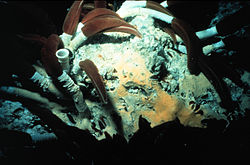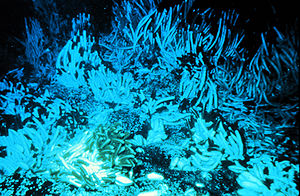Riftia
| Giant Tube worms | |
|---|---|

| |
| Scientific classification | |
| Kingdom: | |
| Phylum: | |
| Class: | |
| Order: | |
| Family: | |
| Genus: | Riftia
|
| Species: | R. pachyptila
|
| Binomial name | |
| Riftia pachyptila M. L. Jones, 1981
| |
Giant tube worms, Riftia pachyptila, are marine invertebrates in the phylum Annelida[1] (formerly grouped in phylum Pogonophora and Vestimentifera) related to tube worms commonly found in the intertidal and pelagic zones. Riftia pachyptila lives over a mile deep, and up to several miles deep, on the floor of the Pacific Ocean near black smokers, and it can tolerate extremely high hydrogen sulfide levels. These worms can reach a length of 2.4 m (7 ft 10 in).
The common name "giant tube worm" is however also applied to the largest living species of shipworm, Kuphus polythalamia, which despite the name "worm" is a bivalve mollusc, not an annelid.
Body structure

They have a highly vascularized, red "plume" at the tip of their free end which is an organ for exchanging compounds with the environment (e.g., H2S, CO2, O2, etc.). The tube worm does not have many predators, as few creatures live on the sea bottom at such depths. If threatened, the plume may be retracted into the worm's protective tube. The plume provides essential nutrients to bacteria living inside a specialized organ within its body (i.e., trophosome) as part of a symbiotic relationship. They are remarkable in that they have no digestive tract, but the bacteria (which may make up half of a worm's body weight) turn oxygen, hydrogen sulfide, carbon dioxide, etc. into organic molecules on which their host worms feed. This process, known as chemosynthesis, was first recognized by Colleen Cavanaugh while she was a graduate student.[2]
The bright red color of the plume structures results from several extraordinarily complex hemoglobins found in them, which contain up to 144 globin chains (presumably each including associated heme structures). These tube worm hemoglobins are remarkable for carrying oxygen in the presence of sulfide, without being completely "poisoned" or inhibited by this molecule, as hemoglobins in most other species are.[3][4]
Nitrate and nitrite are toxic but nitrogen is required for biosynthetic processes. The chemosynthetic bacteria within the trophosome are able to convert this nitrate to ammonium ions, which then are available for production of amino acids in the bacteria, which are in turn released to the tube worm. In order to transport nitrate to the bacteria, R. pachyptila are able to concentrate nitrate in their blood to a concentration that is 100 times more concentrated than the surrounding water. The exact mechanism of R. pachyptila’s ability to withstand and concentrate nitrate is still unknown.[5]
Energy and nutrient source
With sunlight not available directly as a form of energy, the tubeworms rely on bacteria in their habitat to oxidize hydrogen sulfide,[6] using dissolved oxygen in the water for respiration. This reaction provides the energy needed for chemosynthesis. For this reason, tube worms are partially dependent on sunlight as an energy source, since they use free oxygen, which has been liberated by photosynthesis in water layers far above, to obtain nutrients. In this way tubeworms are similar to many forms of life which live in the ocean below depths that sunlight can penetrate. However, tubeworms are unique in being able to use bacteria to indirectly obtain all materials they need for growth from molecules dissolved in water. Tube worm growth resembles that of hydroponically grown fungi more than it does that of typical animals which need to "eat".[citation needed]
Reproduction
To reproduce, Riftia pachyptila females release lipid-rich eggs into the surrounding water so they start to float upwards. The males then unleash sperm bundles that swim to meet the eggs. After the eggs have hatched, the larvae swim down to attach themselves to the rock.
Growth rate and age
Riftia pachyptila has the fastest growth rate of any known marine invertebrate. These organisms have been known to colonize a new site, grow to sexual maturity and increase in length to 4.9 feet (1.5 m) in less than two years.[7] This is in sharp contrast to Lamellibrachia luymesi, the tube worms that live at deep sea cold seeps and grow very slowly for most of their lives. It takes from 170 to 250 years for Lamellibrachia luymesi to grow 2 meters in length, and even longer worms have been discovered.[8]
See also
References
- Notes
- ^ Ruppert, E. (2007). Invertebrate Zoology: A functional Evolutionary Approach (7th ed.). Belmont: Thomson Learning. ISBN 0-03-025982-7.
{{cite book}}: Unknown parameter|coauthors=ignored (|author=suggested) (help) - ^ Cavanaugh, Colleen M.; et al. (1981). "Prokaryotic Cells in the Hydrothermal Vent Tube Worm Riftia pachyptila Jones: Possible Chemoautotrophic Symbionts". Science. 213 (4505): 340–342. doi:10.1126/science.213.4505.340. PMID 17819907.
- ^ Zal F, Lallier FH, Green BN, Vinogradov SN, Toulmond A (1996). "The multi-hemoglobin system of the hydrothermal vent tube worm Riftia pachyptila. II. Complete polypeptide chain composition investigated by maximum entropy analysis of mass spectra" (Free full text). J. Biol. Chem. 271 (15): 8875–81. doi:10.1074/jbc.271.15.8875. ISSN 0021-9258. PMID 8621529.
{{cite journal}}: Unknown parameter|month=ignored (help)CS1 maint: multiple names: authors list (link) CS1 maint: unflagged free DOI (link) - ^ Minic Z, Hervé G (2004). "Biochemical and enzymological aspects of the symbiosis between the deep-sea tubeworm Riftia pachyptila and its bacterial endosymbiont". Eur. J. Biochem. 271 (15): 3093–102. doi:10.1111/j.1432-1033.2004.04248.x. ISSN 0014-2956. PMID 15265029.
{{cite journal}}:|format=requires|url=(help); Unknown parameter|month=ignored (help) - ^ Edda Hahlbeck, Mark A. Pospesel, Franck Zal, James Childress, Horst Felbeck (2005). "Proposed nitrate binding by hemoglobin in Riftia pachyptila" (Free full text). Deep-Sea Research. 52 (10): 1885–1895. doi:10.1016/j.dsr.2004.12.011. ISSN 0967-0637.
{{cite journal}}: Unknown parameter|month=ignored (help)CS1 maint: multiple names: authors list (link) - ^ C.Michael Hogan. 2011. Sulfur. Encyclopedia of Earth, eds. A.Jorgensen and C.J.Cleveland, National Council for Science and the environment, Washington DC
- ^ Lutz, R. A., et al. "Rapid Growth at Deep-sea Vents." Nature 371 (1994): 663–664.
- ^ http://www.sciencedaily.com/releases/2000/02/000203075002.htm
- Further reading
- Minic, Zoran (2004). "Biochemical and enzymological aspects of the symbiosis between the deep-sea tubeworm Riftia pachyptila and its bacterial endosymbiont". European Journal of Biochemistry. 271 (15): 3093–3102. doi:10.1111/j.1432-1033.2004.04248.x. PMID 15265029.
{{cite journal}}: Cite has empty unknown parameter:|month=(help); Unknown parameter|coauthors=ignored (|author=suggested) (help) - Zal, Franck; et al. (1996). "The Multi-hemoglobin System of the Hydrothermal Vent Tube Worm Riftia pachyptila: II. Complete polypeptide chain composition investigated by maximum entropy analysis of mass spectra". Journal of Biological Chemistry. 271 (15): 8875–8881. doi:10.1074/jbc.271.15.8875. PMID 8621529.
{{cite journal}}: Cite has empty unknown parameter:|month=(help)CS1 maint: unflagged free DOI (link)
External links
- Privett, B. (2001). "Riftia pachyptila". Animal Diversity Web. Retrieved February 25, 2008.
- Giant Tube Worm page at the Smithsonian
- Podcast on Giant Tube Worm at the Encyclopedia of Life
- http://www.seasky.org/monsters/sea7a1g.html
- http://www.ucmp.berkeley.edu/annelida/pogonophora.html
- http://www.ocean.udel.edu/deepsea/level-2/creature/tube.html
